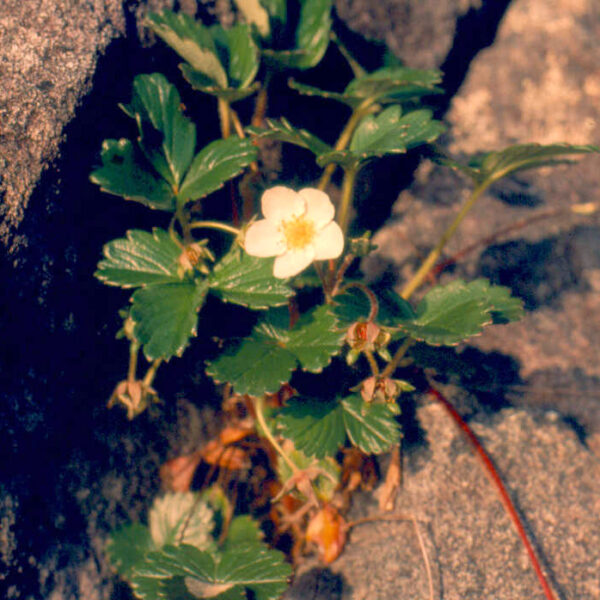Coastal Strawberry
Fragaria chiloensis (L.) Duchesne

overview
A perennial maritime herb growing up to 25 cm tall with short, thick rootstocks connected by short, hairy runners. Leaves are basal on long stocks, thick, leathery strongly veined, coarsely toothed, the terminal tooth shorter than its neighbours. Flowers are white, 3.5 cm across with five to seven petals; five to nine flowers grow on a leafless flowering stalk to 30 cm tall. Fruit is a small, hairy strawberry up to 1.5 cm across (Pojar and MacKinnon, 1994). Photo by Dave Polster.
other names
Pacific coast strawberry, beach strawberry, Chilean strawberry
family
Rosaceae
ecological setting
Dry to mesic sand dunes and rocky coastal bluffs, just above high tide, in the lowland zone; frequent in Coastal BC; N. to Alaska and S. to California; disjunct to South America (Douglas, 1999).
soil texture
Medium to course textured soils (Kartesz, USDA).
nutrients
Nitrogen-medium soils (Klinkenberg, 2004).
soil reaction salinity
pH 5.8 – 7.8 (Kartesz, USDA).
moisture regime
Drought tolerant (Klinkenberg, 2004)
shade tolerance
Full sun to semi-shade (Pettinger, 1996).
bec zone subzone status
Modal BEC Zone Class: ESSF; found in CWH, ESSF, ICH, IDF, SBS (Klinkenberg, 2004).
site rehabilitation
Produce prolific runners with closely spaced plants that have extensive root systems and are important contributors to sand dune binding. Plants also colonize rocky headlands and often are the main vegetation on small, jagged offshore pinnacles. They are drought and salt tolerant and flourish under wind-swept conditions (Daubeny, 2003). Plants associated with F. chiloensis include yarrow (Achillea millefolium), sea pink (Armeria maritima), and kinnikinnick (Arctostaphylos uva-ursi) (Pettinger, 1996).
wildlife
Provides food for birds. The flowers are a nectar source for butterflies such as the Sara orange tip (Pettinger, 1996).
landscaping
Coastal strawberry is an ideal evergreen ground cover for sunny, but not sun-baked sites (Hebda). An excellent drought-tolerant species for full sun and poor soil conditions (Pettinger, 1996). Can be used beside dry pathways (Pettinger, 1996). The species has considerable ornamental value as a ground cover. Its glossy dark green leaves and striking white flowers on the male clones are especially attractive in rockeries or on banks (Daubeny, 2000).
first nations
Stl’atl’imx girls used to wear headbands and belts of strawberry runners plaited together in three or four strands (Turner, 1998). Berries were eaten, but not dried (too juicy). The Saanich and Mainland Comox made tea from the leaves. Quileute chewed leaves & applied as a poultice to burns. Skokomish used the whole plant in a tea for diarrhea. Haida used as ingredient for female tonic (Pojar and MacKinnon, 1994).
flowering time
April to May
fruit ripening time
June to July
seed collection time
June to July
crop intervals
Annual
no seeds per kg
1,205,000
seed viability
82%
collection and abstraction
Mature fruits are red. Seed is dark brown at maturity (Young, 2001).
seed storage
Seeds are kept dry and stored in a refrigerator (Young, 2001).
fruit seed dormancy treatment
Seeds are soaked for 24 hours and stratified for 21 days. Stratification may not be necessary (Young, 2001).
vegetative propagation
Propagates easily by sucker and plant division. Propagate by sucker in fall to early spring, and by plant division in fall (Hebda; Young, 2001).
additional info and photos
For more information and pictures, visit the E-Flora BC website at www.eflora.bc.ca.